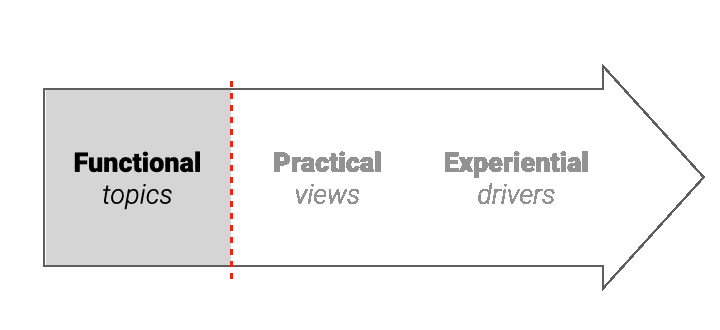What Reddit says about GPT-5: Expectations vs reality
People aren’t dazzled anymore. With GPT-5, the breathless hype, hope and marvel are gone. What’s replacing it? We ran 10,141 posts from Reddit about GPT-5 through narrative analytics to measure what people are really saying.
Open AI’s struggles with GPT-5 have been well covered in the news. But what are the expectations and impressions expressed by real people? There are two basic responses that emerge clearly on opposite sides of the narrative map below. Use the slider on the lower right to toggle between the high level clusters and the detailed narrative themes mentioned in parentheses below.
Doubt (left).
On the left side, the map reveals a baseline of skepticism/doubt. These are the people who had little hope or optimism for GPT-5 in the first place. Or at least that’s what they are saying now. In this area of the map, people were unmoved by hype surrounding the GPT-5 release. People speculate about the release, but don’t make major predictions and aren’t excited (See “Noncommittal speculation” cluster). Their evaluations of GPT-5 are blunt and unemotional – they did not set their expectations high (See "Blunt underwhelm verdicts” cluster).
Dashed hopes (right).
On the right side, the “dashed hopes” stories. The people who had high hopes, measured the performance of GPT-5 based on those high expectations, and faced disappointment. For this crowd, their chatbot is transforming from a companion to mere appliance. People hoped for something different and greater than GPT-5. These people miss the warmth, continuity, and sense of presence they had with GPT-4o (“Emotional backlash,” “What GPT-5 feels like"). They mostly note no notable improvements (“Model comparisons,” “GPT-5 vs. GPT-4o debate”).
Adjust level here
The company vs the user - different priorities?
Company agenda (top).
Comments in this part of the map focus on Open AI’s choices (“Corporate strategy discussions”). In these posts, they question the company’s decisions, with some pleading for OpenAI to bring back presence, options, and reliability that people felt with 4o (See “Feature requests to OpenAI (AMA)” cluster).
Personal & user perspective (bottom).
For regular users, lost tasks, lost time, repeated queries, and workarounds can be frustrating . When people don’t get the speed and efficiency they expect, they don’t hesitate to say it in personal terms (“User complaints and frustrations,” “Post-testing disappointment”). Or in some cases, they call out leaders like Sam Altman (“Sam Altman criticism”).
Keeping up with expectations/competition
The center cluster - and what's missing
Chatbot-based AI is very much seen as a race. Everything in this center part of the map is “versus” in some way: how 4o felt vs GPT-5 (“Feeling out GPT-5"); the choices users had before vs now (“Tool integration & workflows”), what OpenAI delivers vs competitors (“Industry & AGI speculation”), what it delivers vs hype (“Technical performance debates”). The race has changed. Today’s perception is skeptical-to-mixed — people aren’t as amazed as they once were with chatbots and have tempered expectations.
What’s NOT in the map?
Those tempered expectations have changed the narrative landscape around generative AI. Conspicuously absent in the GPT-5 map are the wide-eyed amazement and optimism of past updates and releases. Expectations have changed, and people now have enough experience to question and challenge whatever the press release and the demo may suggest. In an investment landscape where fundraising has been fuelled by fear of missing out, the injection of realism seen in this map may signal the winds are shifting.
What is unique about narrative analytics, compared to other approaches?

~10
2568
1. Every map is unique: Nothing is pre-set
Each map is unique to the dataset, and unique to your data. Narrative maps are created from a huge number of possible combinations of clusters - based on the unique views expressed within your data. This means the analysis is tailored to your business. For this reason, the clusters in narrative maps often correlate more strongly to outcomes, compared to standard one-size-fits all approaches or performance models.
possible cluster/axis combinations
2. Narratives - not just topics
Standard analytical techniques capture topics. A narrative is bigger than a topic, capturing real-world context and experiential drivers:
This allows teams to understand the "reason why" behind the scores. The result is faster, clearer understanding and actionability.


VS

AI Chatbots:
built to talk
Phrasia
built to hear
3. How does it compare to AI chatbots?
Narrative analytics is built on some of the same LLM and deep learning technology as AI chatbots. However, with narrative analytics, the algorithm is 100% focused on hearing, not talking.
Chatbots are designed to give the 'most likely' response to a question. By design, they provide the 'conventional' answer, ignoring outliers which may signal emerging risks and opportunities. Narrative analytics reveals the full landscape, making it easy to detect outliers, and emerging themes, as well as the most common issues.
4. Supporting - not replacing - human judgement
Narrative analytics is designed to involve and engage
people. The transparency of the narrative maps make it easy
to involve non-technical stakeholders in refining and improving
the maps.

Lagging
indicators
VS
Leading
indicators
5. Leading indicators for faster action
Most data dashboards rely on structured data which measures behaviour and outcomes: these are lagging indicators which can leave teams reacting to the scores. Narratives often change before the inflection point when outcomes are decided. For this reason, narrative analytics can help companies intercept early signals in their business, to more proactively manage their business.

